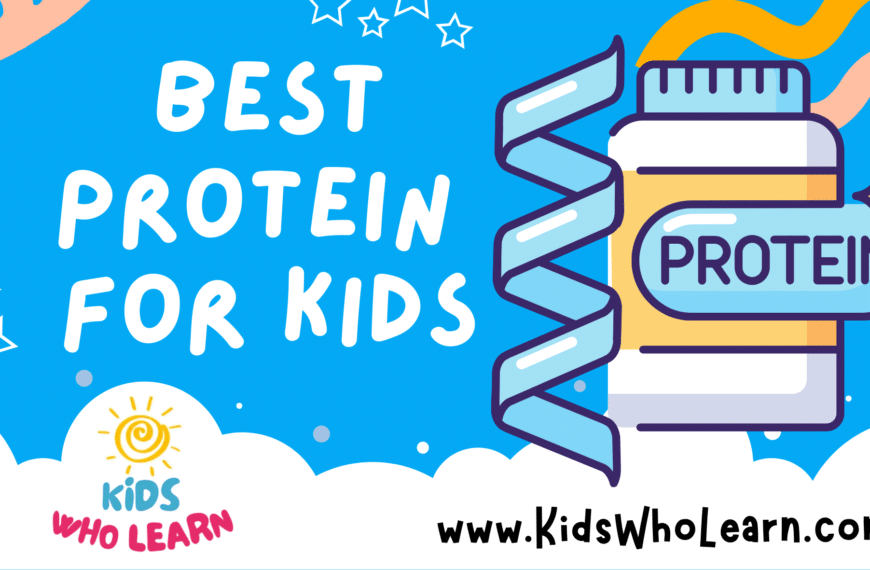Selecting the ideal protein shake for kids involves understanding the role of protein in childhood development. Protein is a crucial building block for the body, supporting growth and repair of tissues. It’s especially important during the formative years when children are growing rapidly. Ensuring that kids get an adequate amount of protein through their diet can sometimes be challenging. Protein shakes can serve as a convenient supplement to help meet these nutritional needs.
When choosing a protein shake for children, it’s essential to consider both the quality and quantity of protein, along with other nutritional factors. A protein shake that’s tailored for kids should have a balanced amount of protein suited to their dietary needs, be low in added sugars, and free from artificial additives. It should also be tasty, as this helps in making sure that children will enjoy consuming it regularly. In addition to protein content, the overall nutritional profile of the shake is important, as it should support a healthy and balanced diet.
Key Takeaways
- Adequate protein intake is vital for children’s growth and tissue repair.
- The best protein shakes for kids are balanced in protein, low in sugar, and free from harmful additives.
- Taste and overall nutrition are key considerations to ensure regular consumption and a balanced diet.
Understanding Protein and its Importance for Kids
Protein is a vital macronutrient crucial for your child’s growth and development. It aids in muscle growth, repairs tissues, and supports a healthy immune system.
Role of Protein in Child Development
Protein plays a central role in your child’s physical development. Muscles, tissues, organs, enzymes, and hormones—all necessary for proper growth—are largely composed of protein. A sufficient intake ensures that your child’s body can carry out these essential building functions. During periods of rapid growth, protein requirements may increase to support the expanding muscle mass and the body’s increasing needs.
Recommended Protein Intake for Various Age Groups
Your child’s protein needs change as they grow. The Recommended Dietary Allowance (RDA) for protein varies by age:
- Ages 1-3: 13 grams per day
- Ages 4-8: 19 grams per day
- Ages 9-13: 34 grams per day
For teens, protein intake depends on gender and activity level:
- Ages 14-18 (girls): 46 grams per day
- Ages 14-18 (boys): 52 grams per day
These numbers serve as a guide; children engaged in regular physical activity may require more protein to support muscle repair and growth.
Essential Amino Acids and Muscle Growth
Protein is made up of amino acids, of which nine are considered essential. These essential amino acids must come from your child’s diet, as the body cannot create them. They are critical for muscle development, especially during periods of quick growth or increased physical activity. Foods that provide all essential amino acids are known as complete proteins and are particularly important in your child’s diet to support their health and proper muscle development. Common sources include meat, dairy products, and eggs, with plant-based options like quinoa and soy products also providing complete protein profiles.
Choosing the Right Protein Shake
When selecting a protein shake for children, it’s crucial to focus on protein content, nutritional value, ingredient quality, and the absence of artificial additives.
Evaluating Protein Content and Quality
Your primary concern should be the protein content and quality. Protein shakes for kids should provide adequate protein to support their growth without exceeding their daily needs. Look for products that feature complete proteins, containing all essential amino acids. Often, whey or casein are good options, as they are effective and readily absorbable protein sources.
Identifying Key Nutrients Beyond Protein
Beyond protein, a balanced shake should include essential vitamins and minerals that kids need for development. Calcium and Vitamin D are crucial for bone health, while iron contributes to cognitive development. Refer to the Nutrition Facts label to ensure the shake includes a well-rounded profile of these nutrients.
Deciphering Labels: Non-GMO, Organic, and Allergens
Labels such as USDA Organic or Non-GMO can indicate higher quality ingredients with fewer pesticides and additives. However, it’s also vital to check for common allergens like dairy, nuts, or soy if your child has sensitivities. Products that are labeled as hypoallergenic are usually formulated to minimize the risk of allergic reaction.
The Significance of Avoiding Artificial Additives
Opt for shakes that are free from artificial sweeteners, flavors, and colors. These additives provide no nutritional benefit and may pose health risks in the long term. Look for shakes using natural ingredients for flavor and sweetness, ensuring your child avoids unnecessary chemicals. Always consult with a pediatrician before incorporating a new protein shake into your child’s diet.
Healthy Ingredients and Recipes
When creating protein shakes for kids, it’s crucial to focus on ingredients that contribute to their growth while being safe and enjoyable. Here are some specifics on how to achieve that with natural sweeteners, healthy fats and fibers, and making smart choices between homemade and store-bought options.
Natural Sweeteners and Flavor Enhancers
Avoiding artificial sweeteners is important for kids. For natural sweetness and flavor, honey is an excellent choice — it’s sweet and has trace nutrients. Chia seeds can be added for a nutritional boost and to thicken the shake. Blending in fruits like pineapple can also amplify the flavor without the need for refined sugars.
Examples:
- 1 tbsp honey
- 1/2 cup pineapple chunks
Incorporating Healthy Fats and Fibers
Healthy fats are essential for children’s development, while fibers help with digestion. Adding Greek yogurt increases the shake’s calcium content and provides healthy fats. Chia seeds offer fiber and can make shakes more filling. Oats are another fiber-rich option that can provide a smooth texture and nutrient boost. For fats, consider nuts or natural peanut butter without added sugars.
Tips:
- Blend in 1/4 cup Greek yogurt for creaminess and calcium.
- Use 1 tbsp of chia seeds or oats for fiber.
Homemade vs. Store-Bought: Making the Right Choice
Control over ingredients is the primary advantage of homemade shakes. You can use whole food ingredients like milk, eggs, and cocoa powder for protein, vitamins, and minerals. Store-bought shakes often contain preservatives and unnecessary additives. By mixing ingredients like milk, ice, and protein powder yourself, you ensure that your child is consuming a shake tailored to their nutritional needs.
Ingredients to Use:
- Whole milk (rich in protein and calcium)
- Fresh or frozen fruit (for natural sweetness)
- Quality protein powder (free of artificial additives)
Protein Shake Varieties and Alternatives
When considering protein shakes for children, it’s crucial to choose an option that meets their protein requirements while accommodating any dietary restrictions or preferences they may have.
Dairy-Based and Lactose-Free Options
For children who can consume dairy, whey protein shakes offer a rich source of this macronutrient and often come in a variety of flavors that appeal to young taste buds. If your child is lactose intolerant or has a mild dairy sensitivity, you can opt for lactose-free whey options or shakes that contain dairy alternatives like lactose-free milk or yogurt.
- Flavors: Chocolate, Vanilla, Strawberry
- Dairy-based sources: Whey, Yogurt, Cheese
- Lactose-Free Brands: (Example) Brand A, Brand B
Plant-Based Proteins: Vegan and Vegetarian Choices
If you’re raising your child on a vegetarian or vegan diet, plant-based protein shakes are an excellent choice. Ingredients like beans, tofu, and plant-based milks (such as almond, soy, or oat) provide necessary protein for active children without animal products.
- Vegan Sources: Soy Protein, Pea Protein, Rice Protein
- Common Base Ingredients: Tofu, Beans, Plant-based milk
- Popular Plant-based Brands: (Example) Brand C, Brand D
Probiotics and Digestive Health
Protein shakes that include probiotics can support your child’s digestive health. Many options incorporate these beneficial bacteria without compromising on taste. Look for shakes that are labeled as containing live cultures or added probiotics. For kids with gluten sensitivities, ensure the shake is marked as gluten-free.
- Gluten-Free Options: Yes/No
- Probiotic Ingredients: Lactobacillus spp., Bifidobacterium spp.
- Digestive Health Brands: (Example) Brand E, Brand F
Nutritional Supplements and Protein Shake Enhancements
In enhancing protein shakes for children, careful selection of vitamins, minerals, and balanced macronutrients ensures they receive essential nutrients that may be lacking in their diets.
Supplementing with Vitamins and Minerals
Protein shakes can be fortified with a range of vitamins and minerals that are crucial for your child’s growth and development. It’s important to look for shakes that include calcium and vitamin D for bone health as well as iron and zinc to support cognitive development.
Essential Nutrients for Active and Picky Eaters
If your child is active or selective with food, ensuring they get enough quality protein and essential nutrients is imperative. A protein shake can provide a concentrated source of nutrients. Enhancements like omega-3 fatty acids can support brain health and antioxidants can bolster the immune system.
Balancing Macronutrients: Proteins, Carbs, and Fats
Your child needs a balance of proteins, carbohydrates, and fats for sustained energy and overall health.
- Proteins: The building blocks of muscles; look for complete proteins that contain all essential amino acids.
- Carbohydrates: Provide your child with energy; opt for complex carbs for longer-lasting energy.
- Fats: Essential for neurological development; include sources of healthy fats like those from avocados or nuts.
Incorporating Protein Shakes into a Balanced Diet
Protein shakes can be a convenient addition to your child’s diet when used appropriately to complement their nutrition. Let’s explore how to integrate these shakes effectively.
Proper Timing and Quantity of Protein Shakes
When introducing protein shakes into your child’s diet, it’s crucial to consider both timing and quantity. The best time to give your child a protein shake is:
- After physical activity, to aid muscle recovery.
- As a mid-morning or mid-afternoon snack to support sustained energy levels.
A safe quantity is generally about 0.5 grams of protein per pound of body weight daily, from all dietary sources. Consult a healthcare provider for personalized advice.
Protein Shakes as Meal Replacements or Snacks
- Meal Replacements: Rarely should protein shakes replace whole meals. If necessary, do so only when you can’t provide a balanced meal.
- Snacks: Use protein shakes as a snack rather than a meal replacement to ensure your child still benefits from the nutrients found in whole foods.
Remember, a shake can fill a nutrition gap but shouldn’t be the cornerstone of any meal plan.
Importance of Hydration and Overall Nutrition
Hydration is just as important as protein intake. Ensure your child drinks plenty of water throughout the day, especially if they consume protein shakes, which may increase the need for fluids.
Overall Nutrition: Protein shakes should complement a diet rich in fruits, vegetables, whole grains, and lean proteins. A variety of foods from all food groups is essential to maintain balanced nutrition for your child.
In summary, use protein shakes judiciously, keeping an eye on your child’s entire diet and hydration needs to promote healthy growth and development.
Buying Guide and Recommendations
When selecting a protein shake for your child, it’s crucial to balance nutritional benefits with taste and cost-effectiveness. Consider non-GMO options and popular brands such as Pediasure and Orgain, and utilize parental feedback for informed decisions.
Top Protein Shake Products for Kids
- Pediasure: Well-known for its balanced nutrition and suitability for picky eaters. Packed with vitamins and minerals, it’s a widely accepted choice.
- Orgain Kids Protein: A plant-based, non-GMO protein shake, free from artificial ingredients, that comes in various kid-friendly flavors.
- Nurished Mighty Chocolate Milk: A hit among kids who prefer chocolate-flavored drinks with the added benefit of essential nutrients.
Understanding Cost Versus Quality
When comparing products:
- Price: Expect to pay anywhere from $1 to $3 per serving. Bulk purchasing can often reduce the cost.
- Quality: Higher-priced shakes generally offer organic or non-GMO ingredients with no artificial additives. Lower-cost options might include more fillers or synthetic ingredients.
Product Ratings and Parental Feedback
On Amazon:
- Pediasure: Average rating of 4.7 out of 5 stars. Parents praise its taste and nutritional content.
- Orgain: Rates at 4.5 out of 5 stars, with parents noting its cleanliness of ingredients.
- Nurished Mighty Chocolate Milk: Scores highly for flavor, but fewer reviews exist, so gather more parent feedback if considering.
| Product | Average Rating | Price Range (per serving) | Non-GMO |
|---|---|---|---|
| Pediasure | 4.7 | $2 – $3 | Varies by product |
| Orgain | 4.5 | $1.50 – $3 | Yes |
| Nurished Mighty Chocolate Milk | 4.5+ | $1 – $2 | Yes |
Consulting Healthcare Professionals
Before choosing a protein shake for your child, it’s crucial to consult with healthcare professionals who can provide personalized advice based on your child’s specific needs.
When to Speak with a Pediatrician or Dietitian
You should discuss with a pediatrician or a registered dietitian before introducing a protein shake to your child’s diet. This is particularly important if your child has unique protein requirements or health concerns. They can assist in determining if supplementation is necessary and ensure it aligns with your child’s nutritional profile.
- Pediatrician: Evaluate general health, growth patterns, and medical history.
- Dietitian: Offer detailed dietary guidance tailored to active children.
Addressing Nutritional Needs and Weight Gain
If your child requires additional nourishment for weight gain or is extremely active, a healthcare professional can propose a protein shake as a boost to their regular meals. However, it’s essential to balance supplementation with a well-rounded diet.
Considerations for Nutritional Needs:
- Adequacy of current diet
- Caloric and protein needs based on activity level
Monitoring Growth and Muscle Recovery
When children engage in sports or vigorous physical activity, proper muscle recovery is vital. Healthcare providers can recommend how to incorporate protein shakes in a way that supports recovery and muscle development without compromising overall growth patterns.
- Growth Monitoring: Track height and weight over time.
- Muscle Recovery: Assess the frequency, intensity, and recovery needs post-activity.
Summary and Key Takeaways
When choosing a protein shake for your child, it’s essential to prioritize their nutritional needs. Look for shakes that:
- Contain high-quality protein: Aim for proteins that are complete, containing all essential amino acids.
- Have minimal added sugars: Sugars should be limited to avoid unnecessary caloric intake.
- Include vitamins and minerals: Essential for a child’s development.
Recommended Ingredients:
- Whey or casein (for non-vegan options)
- Pea or brown rice protein (for vegan options)
- Natural sweeteners, like stevia
Avoid: Artificial colors, preservatives, and excessive sweeteners.
Usage Guidelines:
- Incorporate shakes as part of a balanced diet, not a sole source of nutrition.
- Monitor quantities to align with daily recommended protein intake.
Safety Tips:
- Always consult a pediatrician before introducing a new supplement to your child’s diet.
- Check for potential allergens listed on the label.
Remember to evaluate each protein shake against these criteria to ensure it meets your child’s dietary needs.
Frequently Asked Questions
When selecting protein shakes for your child, it’s imperative to consider nutritional content, age appropriateness, and potential dietary restrictions. Safety and the benefits of natural ingredients over synthetic ones should also be a priority.
What factors should be considered when choosing protein shakes for children?
When choosing a protein shake for your child, examine the protein source, added sugars, and artificial ingredients. It’s crucial to pick a product designed for children’s unique dietary needs and to consult a pediatrician.
Are there any health risks associated with giving protein powder to children?
Protein powders are not always necessary for children and, if consumed in excess, could lead to health issues such as kidney damage. It’s key to adhere to recommended amounts and to choose products without harmful additives.
What are some healthy homemade protein shake recipes for kids?
Healthy homemade protein shakes can be made by blending natural protein sources such as Greek yogurt, milk, or nut butter with fruits, and vegetables. Avoid adding excess sugar or artificial ingredients.
How can protein shakes benefit child athletes in their training?
For child athletes, protein shakes can aid muscle repair and growth when consumed as part of a balanced diet. Ensure the shakes are tailored to children’s needs and do not replace whole foods.
What are the recommended protein intake levels for adolescents?
Adolescents aged 14-18 should aim for 46 grams of protein per day for females and 52 grams for males. It’s important to acquire protein from a balanced diet and only supplement when necessary.
What distinguishes child-specific protein shakes from adult protein supplements?
Child-specific protein shakes generally have lower protein content suitable for their developing bodies and age-appropriate vitamins and minerals. Adult protein supplements may contain excessive protein and other nutrients not recommended for children.












